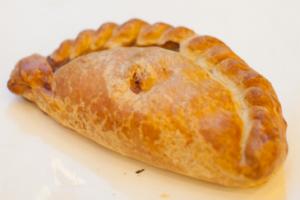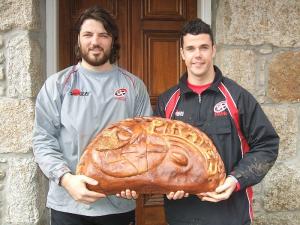


Web: www.cornishpastyassociation.co.uk
The national dish of Cornwall
A pasty is a baked pastry, a traditional variety of which is particularly associated with Cornwall. The pasty is regarded as the national dish of Cornwall, and the term "Cornish pasty" has been in use since at least the early 1860's. It is made by placing an uncooked filling, typically meat and vegetables, on one half of a flat shortcrust pastry circle, folding the pastry in half to wrap the filling in a semicircle and crimping the curved edge to form a seal before baking.
The traditional Cornish pasty, which since 2011 has Protected Geographical Indication (PGI) status in Europe, is filled with beef, sliced or diced potato, swede (also known as yellow turnip or rutabaga – referred to in Cornwall as turnip) and onion, seasoned with salt and pepper, and is baked. Today, the pasty is the food most associated with Cornwall. It is regarded as the national dish and accounts for 6% of the Cornish food economy. Pasties with many different fillings are made and some shops specialise in selling all sorts of pasties.
The origins of the pasty are unclear, though there are many references to them throughout historical documents and fiction. The pasty is now popular world-wide due to the spread of Cornish miners, and variations can be found in Australia, the United States, Argentina, Mexico, Ulster and elsewhere.
The pasty became popular with working people in Cornwall, where tin miners and others adopted it due to its unique shape, forming a complete meal that could be carried easily and eaten without cutlery. In a mine, the pasty's dense, folded pastry could stay warm for several hours, and if it did get cold, it could easily be warmed on a shovel over a candle.
Side-crimped pasties gave rise to the suggestion that the miner might have eaten the pasty holding the thick edge of pastry, which was later discarded, thereby ensuring that his dirty fingers (possibly including traces of arsenic) did not touch food or his mouth. However, many old photographs show that pasties were wrapped in bags made of paper or muslin and were eaten from end-to-end; according to the earliest Cornish recipe book, published in 1929, this is "the true Cornish way" to eat a pasty. Another theory suggests that pasties were marked at one end with an initial and then eaten from the other end so that if not finished in one go, they could easily be reclaimed by their owners.
In 2006, a researcher in Devon discovered a list of ingredients for a pasty tucked inside an audit book and dated 1510, calculating the cost of making a venison pasty. This replaced the previous oldest recipe, dated 1746, held by the Cornwall Records Office in Truro. The dish at the time was cooked with venison, in this case from the Mount Edgcumbe Estate, as the pasty was then considered a luxury meal.
The recipe for a Cornish pasty, as defined by its protected status, includes diced or minced beef, onion, potato and swede in rough chunks along with some "light peppery" seasoning. The cut of beef used is generally skirt steak. Swede is sometimes called turnip in Cornwall, but the recipe requires use of actual swede, not turnip. Pasty ingredients are usually seasoned with salt and pepper, depending on individual taste. The use of carrot in a traditional Cornish pasty is frowned upon, though it does appear regularly in recipes.

The type of pastry used is not defined, as long as it is golden in colour and will not crack during the cooking or cooling, although modern pasties almost always use a shortcrust pastry. There is a humorous belief that the pastry on a good pasty should be strong enough to withstand a drop down a mine shaft, and indeed the barley flour that was usually used does make hard dense pastry.
Although the officially protected Cornish pasty has a specific ingredients list, old Cornish cookery books show that pasties were generally made from whatever food was available. Indeed, the earliest recorded pasty recipes include venison, not beef. "Pasty" has always been a generic name for the shape and can contain a variety of fillings, including stilton cheese, vegetarian and even chicken tikka. Pork and apple pasties are readily available in shops throughout Cornwall and Devon, with the ingredients including an apple flavoured sauce, mixed together throughout the pasty, as well as sweet pasties with ingredients such as apple and fig or chocolate and banana, which are common in some areas of Cornwall.
Migrating Cornish miners and their families (colloquially known as Cousin Jacks and Cousin Jennies) helped to spread pasties into the rest of the world during the 19th century. As tin mining in Cornwall began to decline, miners took their expertise and traditions to new mining regions around the world.
As the national dish of Cornwall, several oversized versions of the pasty have been created in the county. For example, a giant pasty is paraded from Polruan to Fowey through the streets during regatta week. Similarly, a giant pasty is paraded around the ground of the Cornish Pirates rugby team on St. Piran's Day before it is passed over the goal posts.
The world's largest Cornish pasty was made in August 2010, measuring 15 feet and weighing 1,900 lb. It was created by "Proper Cornish" bakers, using 364 pounds of beef, 180 pounds of swede, 100 pound of potatoes and 75 pounds of onions. The pasty was estimated to cost £7,000 and contain 1.75 million calories.
Ginsters is a company founded in 1969 and based in Callington, they are the biggest selling pasty maker in the UK.
The World Pasty Championships are held at the Eden Project in early March, in the heart of Cornwall and celebrate the traditional Cornish pasty, as well as some more unusual varieties. From the Americas to Australia, pasties derived from recipes passed down by Cornish emigrants over centuries are eaten and enjoyed by many millions of people. Entries come from around the world.
Cornish Cafes Mining in Cornwall Cornwall's Farm Shops